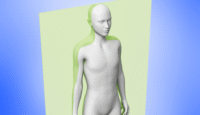Adapted from a creative statistics lesson taught by master science educator Mark Krotec, this pre-lab investigation introduces the value of statistics, the inherent qualities of uncertainty, and data interpretation. Students are asked to discredit the claim that their teacher possesses psychic ability by using a clever card trick, a careful experimental design protocol, and the application of the chi-square test.
The Psychic Professor Problem
Activity time requirements
Preparation: 5 minutes
Guided investigation: 25 minutes
Materials
- 5 Bicycle® Playing Cards (king, queen, ace, jack, and marked joker)
- Several Unopened (new) Decks of Bicycle® Playing Cards
- Blue Pen (to mark joker card)
- Chi-Square Table
- Calculator

Procedure
- Using a blue marker, mark the back of the joker card in a subtle manner so that only you, the teacher, are aware of the card’s identity once flipped over. See Fig. 1.
- The paranormal claim: Explain to the class that you possess psychic abilities that enable you to pick a joker out of a set of 5 cards. Do this before introducing the chi-square test.
- Ask a student to rearrange the 5 cards (1 of which is a marked joker card) in any manner. Turn your back on the class and cover your ears for added effect.
- Simply identify the joker every time based on your insider information. Do this 10 or so times for greater impact.
- Ask students to decide how many correct choices out of 30 trials would be expected due to chance alone. Students should decide the following:
- 1 joker (correct choice) 5 possible outcomes = 0.2, or 20% of the time. Therefore, students should expect that a non-psychic teacher should be able to choose randomly the joker card 6 times out of 30 attempts.
- Write on the board: Expected = 6 correct trials, 24 incorrect trials
- Now ask the students how many correct choices out of 30 trials would be needed to convince them that their teacher possesses psychic abilities.
- Let’s say that they would observe 27 correct choices.
- Write on the board: Observed = 27 correct trials, 3 incorrect trials
- Now establish the hypotheses. Students should be guided to state 2 mutually exclusive hypotheses: a null hypothesis (H0) and an alternate hypothesis (HA). Typically, the hypotheses take the following form during a chi-square test:
- H0: The data are consistent with a specified distribution.
- HA: The data are not consistent with a specified distribution.
- For the sake of this pre-lab investigation, introduce the 2 opposing hypotheses simply as:
- Null Hypothesis (H0): The likelihood that my teacher picks the correct card will not be significantly different from a frequency of 0.2, or the likelihood of picking 6 correct choices out of 30 trials due to random chance alone.
- Alternate Hypothesis (HA): The likelihood that my teacher picks the correct card WILL be significantly different from a frequency of 0.2, or the likelihood of picking 6 correct choices out of 30 trials due to random chance alone.
- Ask students to help you fill out a chi-square table (see Table 1 below). Let them know that the value obtained will allow them to determine which of the 2 hypotheses will be accepted based on the test performed, and which of the 2 will be rejected.
| OUTCOME | Observed | Expected | (O—E) | (O—E)2 | (O—E)2/E |
|---|---|---|---|---|---|
| Correct | 27 | 6 | 21 | 441 | 73.5 |
| Incorrect | 3 | 24 | —21 | 441 | 18.4 |
| Sum = | 91.9 = x2 |
In the example above, a chi-square value of 91.9 is calculated with 1 degree of freedom. The degrees of freedom are calculated according to the formula:
# of possible outcomes — 1
Because the outcome of this experiment is binary (correct/incorrect), then there is 1 degree of freedom.
| Probability (p) value | Probability (p) value | |||||||||
| ACCEPT NULL HYPOTHESIS | REJECT | |||||||||
| 0.95 | 0.80 | 0.70 | 0.50 | 0.30 | 0.20 | 0.10 | 0.05 | 0.01 | 0.005 | |
| 1 | 0.004 | 0.06 | 0.15 | 0.46 | 1.07 | 1.64 | 2.71 | 3.84 | 6.64 | 7.88 |
| 2 | 0.10 | 0.45 | 0.71 | 1.30 | 2.41 | 3.22 | 4.60 | 5.99 | 9.21 | 10.59 |
| 3 | 0.35 | 1.00 | 1.42 | 2.37 | 3.67 | 4.64 | 6.25 | 7.82 | 11.34 | 12.38 |
| 4 | 0.71 | 1.65 | 2.20 | 3.36 | 4.88 | 5.99 | 7.78 | 9.49 | 13.28 | 14.86 |
| 5 | 1.14 | 2.34 | 3.00 | 4.35 | 6.06 | 7.29 | 9.24 | 11.07 | 15.09 | 16.75 |
| 6 | 1.64 | 3.07 | 3.38 | 5.35 | 7.23 | 8.56 | 10.65 | 12.59 | 16.81 | 18.55 |
| 7 | 2.17 | 3.84 | 4.67 | 6.35 | 8.38 | 9.80 | 12.02 | 14.07 | 18.48 | 20.28 |
| Table 2: Chi-Square Table | ||||||||||
According to the chi-square table, it is necessary to reject the null hypothesis in favor of an alternate hypothesis. What does this mean? The chi-square test indicates only whether 2 variables are independent. A definite claim that the teacher has psychic abilities cannot be made. However, we can say that this particular test indicates that there is a significant difference between what is observed and what was expected.
- Allow students to use their unopened card decks to test their psychic abilities. They will need to accept their null hypothesis as long as their sample size is large enough.
- Finally, your students should be circumspect regarding your pseudoscientific claims. Remind them that you (the teacher) were in control of every aspect of the test. You chose the initial cards, and you were able to validate your correct choices when the card was flipped over to reveal a joker.
- Now it is time for your students to design a fair test of your psychic abilities. They should design an experiment with an unopened deck of cards and not allow the teacher to validate the outcome of the card picked. They will simply collect data and then run the chi-square analysis. Once they run the chi-square test under their carefully designed experiment, students should be able to refute the claim that their teacher has psychic abilities.
This advanced kit, which reinforces data analysis, visualization, and statistical evaluation skills, is a great opener or end-of-year review for your AP® Biology class. The optional pre-lab inquiry, when students test a hypothesis during a demonstrated magic trick, emphasizes to students the value of statistics when applied to hypothesis testing. Next, students complete any or all 3 guided-inquiry-based activities to reinforce their understanding of Mendelian genetics, chi-square test for fit, and other concepts.
Advanced–For experienced high school and college classes; requires some technical skill and background knowledge.





